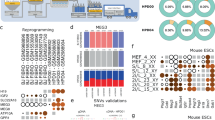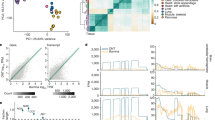Abstract
We developed a digital RNA allelotyping method for quantitatively interrogating allele-specific gene expression. This method involves ultra-deep sequencing of padlock-captured single-nucleotide polymorphisms (SNPs) from the transcriptome. We characterized four cell lines established from two human subjects in the Personal Genome Project. Approximately 11–22% of the heterozygous mRNA-associated SNPs showed allele-specific expression in each cell line and 4.3–8.5% were tissue-specific, suggesting the presence of tissue-specific cis regulation. When we applied allelotyping to two pairs of sibling human embryonic stem cell lines, the sibling lines were more similar in allele-specific expression than were the genetically unrelated lines. We found that the variation of allelic ratios in gene expression among different cell lines was primarily explained by genetic variations, much more so than by specific tissue types or growth conditions. Comparison of expressed SNPs on the sense and antisense transcripts suggested that allelic ratios are primarily determined by cis-regulatory mechanisms on the sense transcripts.
This is a preview of subscription content, access via your institution
Access options
Subscribe to this journal
Receive 12 print issues and online access
$259.00 per year
only $21.58 per issue
Buy this article
- Purchase on Springer Link
- Instant access to full article PDF
Prices may be subject to local taxes which are calculated during checkout



Similar content being viewed by others
References
Yan, H., Yuan, W., Velculescu, V.E., Vogelstein, B. & Kinzler, K.W. Allelic variation in human gene expression. Science 297, 1143 (2002).
Pastinen, T. & Hudson, T.J. Cis-acting regulatory variation in the human genome. Science 306, 647–650 (2004).
Lo, H.S. et al. Allelic variation in gene expression is common in the human genome. Genome Res. 13, 1855–1862 (2003).
Knight, J.C., Keating, B.J., Rockett, K.A. & Kwiatkowski, D.P. In vivo characterization of regulatory polymorphisms by allele-specific quantification of RNA polymerase loading. Nat. Genet. 33, 469–475 (2003).
Serre, D. et al. Differential allelic expression in the human genome: a robust approach to identify genetic and epigenetic cis-acting mechanisms regulating gene expression. PLoS Genet. 4, e1000006 (2008).
Maynard, N.D., Chen, J., Stuart, R.K., Fan, J.B. & Ren, B. Genome-wide mapping of allele-specific protein-DNA interactions in human cells. Nat. Methods 5, 307–309 (2008).
Pant, P.V. et al. Analysis of allelic differential expression in human white blood cells. Genome Res. 16, 331–339 (2006).
Milani, L. et al. Allelic imbalance in gene expression as a guide to cis-acting regulatory single nucleotide polymorphisms in cancer cells. Nucleic Acids Res. 35, e34 (2007).
Cloonan, N. et al. Stem cell transcriptome profiling via massive-scale mRNA sequencing. Nat. Methods 5, 613–619 (2008).
Mortazavi, A., Williams, B.A., McCue, K., Schaeffer, L. & Wold, B. Mapping and quantifying mammalian transcriptomes by RNA-Seq. Nat. Methods 5, 621–628 (2008).
Nilsson, M. et al. Padlock probes: circularizing oligonucleotides for localized DNA detection. Science 265, 2085–2088 (1994).
Hardenbol, P. et al. Multiplexed genotyping with sequence-tagged molecular inversion probes. Nat. Biotechnol. 21, 673–678 (2003).
Hardenbol, P. et al. Highly multiplexed molecular inversion probe genotyping: over 10,000 targeted SNPs genotyped in a single tube assay. Genome Res. 15, 269–275 (2005).
Porreca, G.J. et al. Multiplex amplification of large sets of human exons. Nat. Methods 4, 931–936 (2007).
Deng, J. et al. Targeted bisulfite sequencing reveals changes in DNA methylation associated with nuclear reprogramming. Nat. Biotechnol. 27, 353–360 (2009).
Ge, B. et al. Survey of allelic expression using EST mining. Genome Res. 15, 1584–1591 (2005).
Emilsson, V. et al. Genetics of gene expression and its effect on disease. Nature 452, 423–428 (2008).
Chen, A.E. et al. Optimal timing of inner cell mass isolation increases the efficiency of human embryonic stem cell derivation and allows generation of sibling cell lines. Cell Stem Cell 4, 103–106 (2009).
He, Y., Vogelstein, B., Velculescu, V.E., Papadopoulos, N. & Kinzler, K.W. The antisense transcriptomes of human cells. Science 322, 1855–1857 (2008).
Hoffman, L.M. et al. X-inactivation status varies in human embryonic stem cell lines. Stem Cells 23, 1468–1478 (2005).
Shen, Y. et al. X-inactivation in female human embryonic stem cells is in a nonrandom pattern and prone to epigenetic alterations. Proc. Natl. Acad. Sci. USA 105, 4709–4714 (2008).
Silva, S.S., Rowntree, R.K., Mekhoubad, S. & Lee, J.T. X-chromosome inactivation and epigenetic fluidity in human embryonic stem cells. Proc. Natl. Acad. Sci. USA 105, 4820–4825 (2008).
Ng, P.C. et al. Genetic variation in an individual human exome. PLoS Genet. 4, e1000160 (2008).
Bjornsson, H.T. et al. SNP-specific array-based allele-specific expression analysis. Genome Res. 18, 771–779 (2008).
Milani, L. et al. Allele-specific gene expression patterns in primary leukemic cells reveal regulation of gene expression by CpG site methylation. Genome Res. 19, 1–11 (2009).
Gimelbrant, A., Hutchinson, J.N., Thompson, B.R. & Chess, A. Widespread monoallelic expression on human autosomes. Science 318, 1136–1140 (2007).
Dixon, A.L. et al. A genome-wide association study of global gene expression. Nat. Genet. 39, 1202–1207 (2007).
Stranger, B.E. et al. Population genomics of human gene expression. Nat. Genet. 39, 1217–1224 (2007).
Takahashi, K. et al. Induction of pluripotent stem cells from adult human fibroblasts by defined factors. Cell 131, 861–872 (2007).
Dimos, J.T. et al. Induced pluripotent stem cells generated from patients with ALS can be differentiated into motor neurons. Science 321, 1218–1221 (2008).
Acknowledgements
We thank C. Ludka and Narimene Lekmine for assistance for Illumina sequencing. This study was supported by National Human Genome Research Institute (P50-HG003170); National Heart, Lung and Blood Institute (R01-HL094963); the Broad Institute and Personal Genome Project donations (to G.M.C.); and the new faculty startup fund from the University of California at San Diego (to K.Z.). J.D. was sponsored by a California Institute of Regenerative Medicine postdoctoral fellowship.
Author information
Authors and Affiliations
Contributions
K.Z. and J.B.L. developed and optimized the digital allelotyping method; J.D., Z.L. and J.L. participated in the experiments; D.E. and K.E. provided DNA/RNA of hESCs; E.M.L. provided oligonucleotide libraries; Y.G. and B.X. performed Illumina sequencing. K.Z., J.B.L. and J.A. performed data analysis; and K.Z. and G.M.C. oversaw the project.
Corresponding authors
Ethics declarations
Competing interests
G.M.C. has advisory roles, royalties and/or equity holding in several next-generation sequencing companies. He donates these funds to PersonalGenomes.org.
E.M.L. is an employee of Agilent Technologies Inc.
Supplementary information
Supplementary Text and Figures
Supplementary Figures 1–6, Supplementary Table 1 and Supplementary Note (PDF 593 kb)
Supplementary Table 2
Detailed information of the CES27k probe set. (XLS 11282 kb)
Rights and permissions
About this article
Cite this article
Zhang, K., Li, J., Gao, Y. et al. Digital RNA allelotyping reveals tissue-specific and allele-specific gene expression in human. Nat Methods 6, 613–618 (2009). https://doi.org/10.1038/nmeth.1357
Received:
Accepted:
Published:
Issue Date:
DOI: https://doi.org/10.1038/nmeth.1357
This article is cited by
-
Allelic imbalance of HLA-B expression in human lung cells infected with coronavirus and other respiratory viruses
European Journal of Human Genetics (2022)
-
Recovering genotypes and phenotypes using allele-specific genes
Genome Biology (2021)
-
Investigation of allele specific expression in various tissues of broiler chickens using the detection tool VADT
Scientific Reports (2021)
-
3D mapping and accelerated super-resolution imaging of the human genome using in situ sequencing
Nature Methods (2020)
-
Analysis of public RNA-sequencing data reveals biological consequences of genetic heterogeneity in cell line populations
Scientific Reports (2018)



